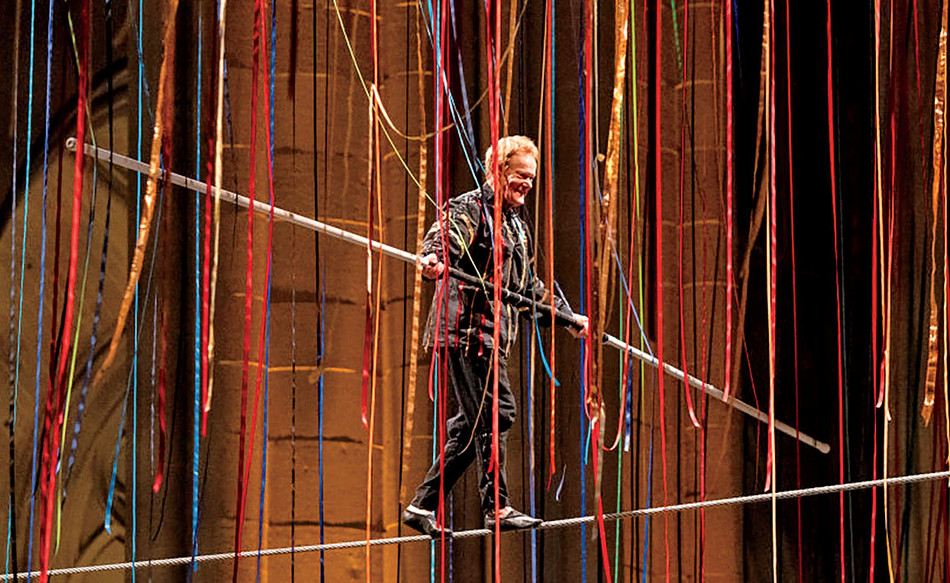Tightrope Walker Philippe Petit Tackles the Cathedral of St. John the Divine (Again)
Earlier this year, when Philippe Petit placed a delicate slippered foot on a slender steel cable strung between two pillars in the nave of the Cathedral of St. John the Divine, it wasn’t just a performance. The great aerialist was also taking another step in his long love affair with the neighborhood.
More than forty years had passed since Petit first walked in the air at St. John’s. Now, in 2024, he was aloft again, merging his performance, called The Ribbon Walk, with an art installation by Anne Patterson titled Divine Pathways. The work consisted of hundreds of long ribbons of blue and green, red and orange, white and gold, hanging like vines from the vault of the ceiling. Petit was poised to make his way through them.
Some in the audience of 1,400 wide-eyed souls could remember the day in 1982 when Petit, to kick off a new phase of construction at the cathedral, rigged a wire 150 feet high over Amsterdam Avenue at 112th Street. The cable was less than an inch thick and stretched from a ledge above the cathedral’s rose window to an apartment building across the street. Petit, then the new artist-in-residence at St. John’s (a position he still holds), walked the length of it. As a performer whose stage is literally the world, Petit loves dramatic, beautiful backdrops, and the intricately carved limestone façade of one of the world’s largest cathedrals was a natural setting for him. Eleven years before, he had walked between the towers of the Cathedral of Notre-Dame in his hometown of Paris; and in 1974 in New York, he and his cohorts covertly fastened a wire between the roofs of the Twin Towers. Petit crossed and recrossed that plunging chasm in a piece of theater that witnesses described in the language of religious awe.
The Twin Towers exploit was portrayed in all its suspense and ecstasy in the 2008 Oscar-winning documentary Man on Wire, coproduced by Columbia film professor Maureen Ryan ’92SOA, who calls the event “a miracle.” Watching Petit on a tightrope, Ryan says, “You’re looking up into the heavens — and he’s up there and he seems untouchable. It just has this transcendence.”
Writers through the ages have tried to capture the feeling of watching an artist perform on the very edge of life. That day in 1982, the novelist Paul Auster ’69CC, ’70GSAS stood on the cathedral steps among the neighbors, clergy, Columbia students, and VIPs who had come to behold the spectacle above Amsterdam Avenue. Auster had seen Petit perform on the streets of Paris and had decided that his vocation was of the highest order: “No art, it seems to me, so clearly emphasizes the deep aesthetic impulse inside us all,” Auster wrote in a 1982 essay. Three years later he would translate Petit’s book On the High Wire. Indeed, Auster could not walk past Notre-Dame without thinking of “an almost invisible wire stretched between the enormous towers of the cathedral, and there, right in the middle, as if suspended magically in space, the tiniest of human figures, a dot of life against the sky.”
For The Ribbon Walk, Petit was closer to terra firma and fifty years removed from the Twin Towers. He was seventy-four now, not twenty-four. And instead of being 1,350 feet above concrete in Lower Manhattan, he was twenty feet above a marble floor in Morningside Heights — still high enough to keep onlookers tense with the age-old question: what if?
Holding his balancing pole before him, Petit traversed the wire with slow, precise, fluid steps. There was no wind, but there were plenty of ribbons. Petit maneuvered the pole, which animated the ribbons, creating slow undulations that in one moment suggested a matador’s cape and in the next the wings of a giant butterfly. Petit made multiple passes along the thirty-eight feet of cable. At several points, a fluttering ribbon wrapped around his leg, and he had to deftly disentangle himself — which sent more than a few hearts into throats.
But Petit, as ever, was firmly in control. When he finished his walk, a wave of applause (and relief) rose up and rolled over the cavernous room. One woman said, “I can breathe now.” A man wondered aloud why he, or anyone, had chosen to watch such a thing.
Forty years earlier, Auster had provided an answer. “Each time we see a man walk on the wire, a part of us is up there with him,” Auster wrote. “Unlike performances in the other arts, the experience of the high wire is direct, unmediated, simple, and it requires no explanation whatsoever. The art is the thing itself, a life in its most naked delineation. And if there is beauty in this, it is because of the beauty we feel inside ourselves.”
This article appears in the Spring/Summer 2024 print edition of Columbia Magazine with the title "Divine Crossings."



